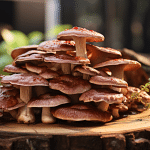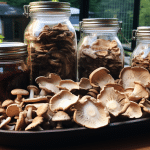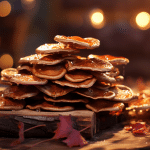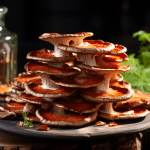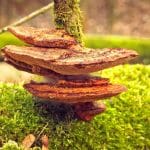Reishi mushrooms are some of the easiest mushrooms to identify, making them an excellent starting point for new mushroom hunters. They do not have any toxic appearances, so are also relatively safe.
Although generally a little too harsh for eating, the medicinal benefits of reishi are well documented. There are many different species of reishi, each growing wild in different regions of the world. For the most part, their medicinal properties are similar, and there is some debate about whether or not they are really the same species that occupies different habitat niches.
All species thrive on dead and dying trees, producing annual harvests. Once you locate Reishi on a specific log or stump, it will continue producing annually there until it has consumed all of its wooden substrate. Reishi mushrooms are also known as Lingzhi, Immortal Mushroom, Ten Thousand Year Mushroom, Spiritual Potency Herb, Varnish Shelf, and Artists Conk.
Wild Reishi Mushroom Identification
The mushrooms themselves are kidney-shaped, or fan-shaped, with distinctive red-orange coloring, with shiny, lacquered surfaces at the top. It is a polypore, so there are no gills, but the underside is white (or tan or gray on older specimens) with a dot that looks like a fingernail. The flesh on the underside will form brown/tan bruises if you push on it.
Only harvest fresh mushrooms that have a white underside, because these mushrooms may harbor harmful moulds once past their prime, or have been bruised and damaged. Because they are easy to bruise and damaged when harvested, reishi must be stored promptly after harvest.
They range from about one-inch to one-foot wide, and may be up to two inches thick. More often, they will be between 4 to 6 inches wide and between 1/2 inch to 1 inch thick.
New growth at the front edges starts off white, gradually turning to a reddish-orange color. Young mushrooms growing quickly can appear primarily white when emerging from wood.
The vibrant orange-red caps characteristic of hemlock reishi will appear when they are fully grown. As the reishi grow older, their meat becomes harder, and the bright caps start to fade.
On my land, reishi rarely last more than a couple of days before slugs start devouring them. Harvest time in Ohio is just around summer solstice, and I am going out every day making sure to get mushrooms before the slugs devour them.
Reishi grow horizontally from their host log, usually with very short to nonexistent stalks. They have a harsh yet pleasant, woodsy smell, kind of like rotting leaves in a mulch. Spores come out from the base of the mushrooms, and on the stumps, where they grow on top of each other, you can see that spores released from the top mushrooms are dimming the caps on the mushrooms underneath. Spore prints are a dull shade of brown on all species.
Wild Reishi Mushroom Species
Identifying Reishi mushrooms differs slightly from area to area, since various species evolved depending on the locale.
You can find our favorite capsules, powders, and tincture’s on the following pages of our website and learn more about each individually:
The Best Reishi Mushroom Supplement
The Best Reishi Mushroom Powder
The Best Reishi Mushroom Tincture
The Best Reishi Mushroom Mushroom Gummies
Ganoderma tsugae
Although almost always found on hemlock, occasionally you may find it on Birch or Maple, as long as it is growing near the hemlock. They can be found fresh from May through July. This species is also known as the Hemlock Vine Shelf.
Ganoderma lucidum
It grows on hardwoods (especially oaks) in warmer regions, such as Asia, the South Pacific, southern Europe, and the Southeastern United States.
Ganoderma applanatum
Colors are duller than others, lacking in shiny luster. Very hard to cut, often having to be sawed off in strips for drying. This species is a specialist, found in many different woods, in both hardwoods and softwoods.
Ganoderma sessile
The meat is extremely soft and pliable, and unlike the rest of the species, it produces sap-like resin when damaged at the external growing edge. Found on hardwoods, typically Oak or Maple, but sometimes also other hardwoods.
Ganoderma curtisii
It has a matte finish, not lacquer, to the top. Found on hardwood logs, typically Oak or Maple, but sometimes other hardwoods.
Ganoderma oregonense
The fruit bodies are extremely large, measuring up to one meter in diameter. Other species include: Ganoderma lingzhi, Ganoderma capense, Ganoderma carnosum, and Ganoderma resinaceum.
Additional Resources:
How Do You Cook Reishi Mushroom?
Updated 10/21/2022








